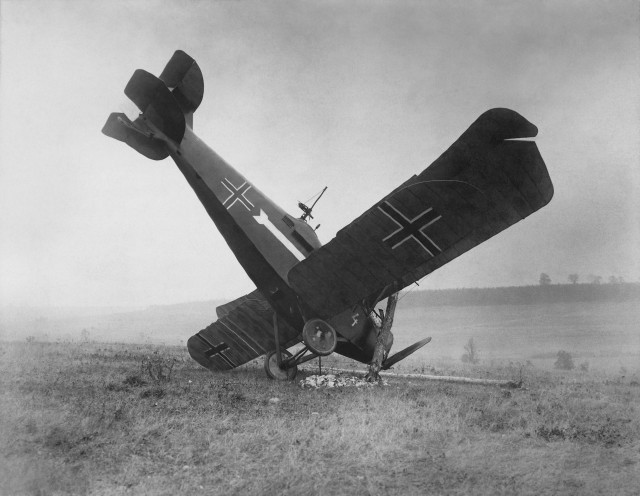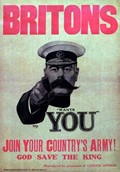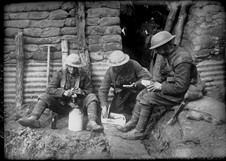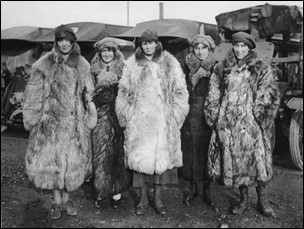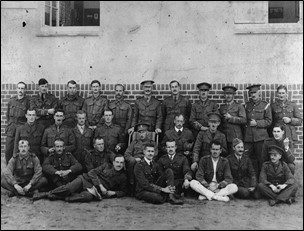
|
|
|
Privacy Policy | Editorial Policy | Profit Policy | Join the Association | List of Members | Contact us | Index | Links
Back Go to page: 1 2 3 4 5 6 7 8 9 10 11 12 13 14 15 16 17 18 19 20 Forward
Contents
1967 Laverton RL team awards night.
Breakfasting one morning in April.
RAAF Motto - Per Ardua ad Astra.
1967 Laverton RL Team.
Jo Hamwood sent us these two pics, he can’t remember all the names, can you help?
.jpg)
Standing L-R: Don’t know, Phil Hazel, Don’t know, Jo Hamwood, Don’t know, Gary Keleher, Don Parks, Don’t know, Ric Dwyer, Don’t know, FlLt Scott,
Kneeling L-R: Don’t know, Don’t know, Don’t know, ? Sibthorpe, Warren Turner, Wayne Ison, Don’t know, Joe Zarate
1967 Laverton RL Awards night.
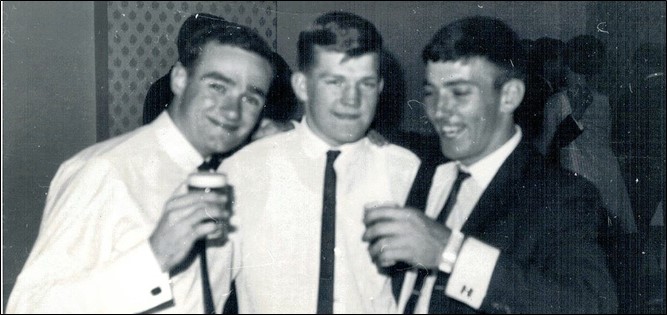
Wayne Ison, ? Sibthorpe, Warren Turner (Captain)
Breakfasting, one morning in April.
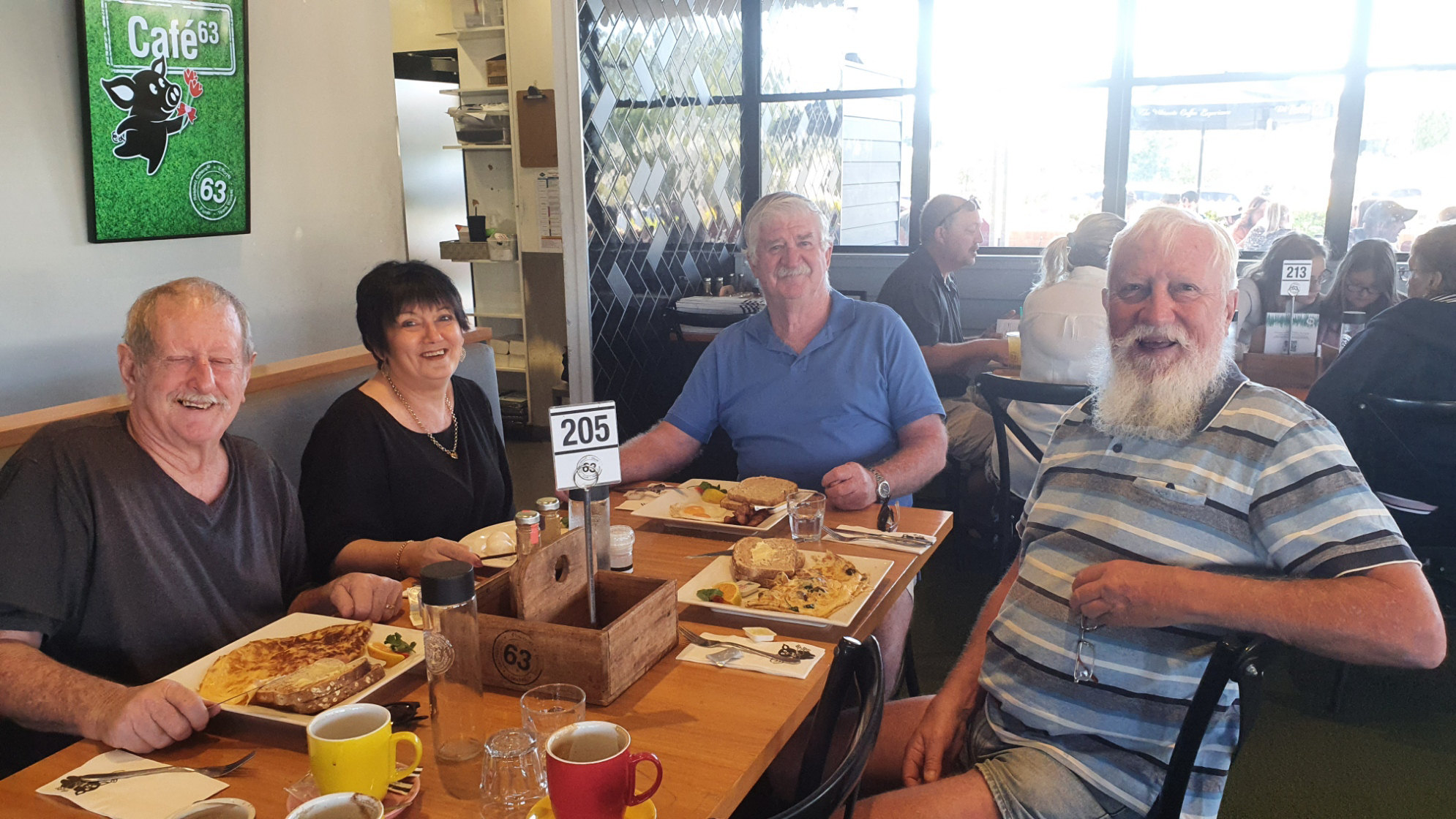
Wayne and Suzy Smith, Trev Benneworth, Kev Rosser.
The Air Force ensign.
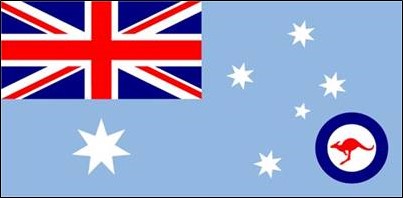
With the formation of the Royal Australian Air Force on 31 March 1921, a new flag was needed to be flown on a mast at the entrance to Air Force bases. Although several uniquely Australian designs were proposed, the Australian Air Council directed in 1922 that the RAAF would use the RAF Ensign ‘without difference’. The RAF Ensign is a light blue (Air Force Blue) British Ensign emblazoned with a large RAF Roundel. This Roundel consists of concentric circles of red, white and dark blue.
In 1948 it was decided to change the RAAF Ensign to better reflect the Australian character, consequently the Southern Cross and the Commonwealth Star were added and the RAF Roundel, although retained, was reduced in size. This design was granted Royal approval in January 1949. This ensign was flown at the entrance of all RAAF establishments until 1982. In 1956, the Air Force replaced the RAF Roundel on the side of its aircraft with a distinctive RAAF Roundel consisting of a red kangaroo-in-motion surrounded by a blue circle, however, the RAAF Ensign with its RAF Roundel remained unchanged.
In 1981, Her Majesty Queen Elizabeth II approved a new design for the RAAF Ensign. The only change was the replacement of the RAF Roundel with the RAAF Roundel containing the red kangaroo-in-motion at its centre. A proclamation was made by the Governor-General on 6 May 1982 recognising the new design, under section 5 of the Flags Act 1953, as the Ensign of the Royal Australian Air Force.
Point Cook.
No. 1 Flying Training School (No. 1 FTS) is one of the Air Force's original units, dating back to the service's formation in 1921, when it was established at RAAF Point Cook. By the early 1930s, the school comprised training, fighter, and seaplane components. It was re-formed several times in the ensuing years, initially as No. 1 Service Flying Training School (No. 1 SFTS) in 1940, under the wartime Empire Air Training Scheme. After graduating nearly 3,000 pilots, No. 1 SFTS was disbanded in late 1944, when there was no further requirement to train Australian aircrew for service in Europe.
The school was re-established in 1946 as No. 1 FTS at RAAF Station Uranquinty, Near Wagga in New South Wales, and transferred to Point Cook the following year.
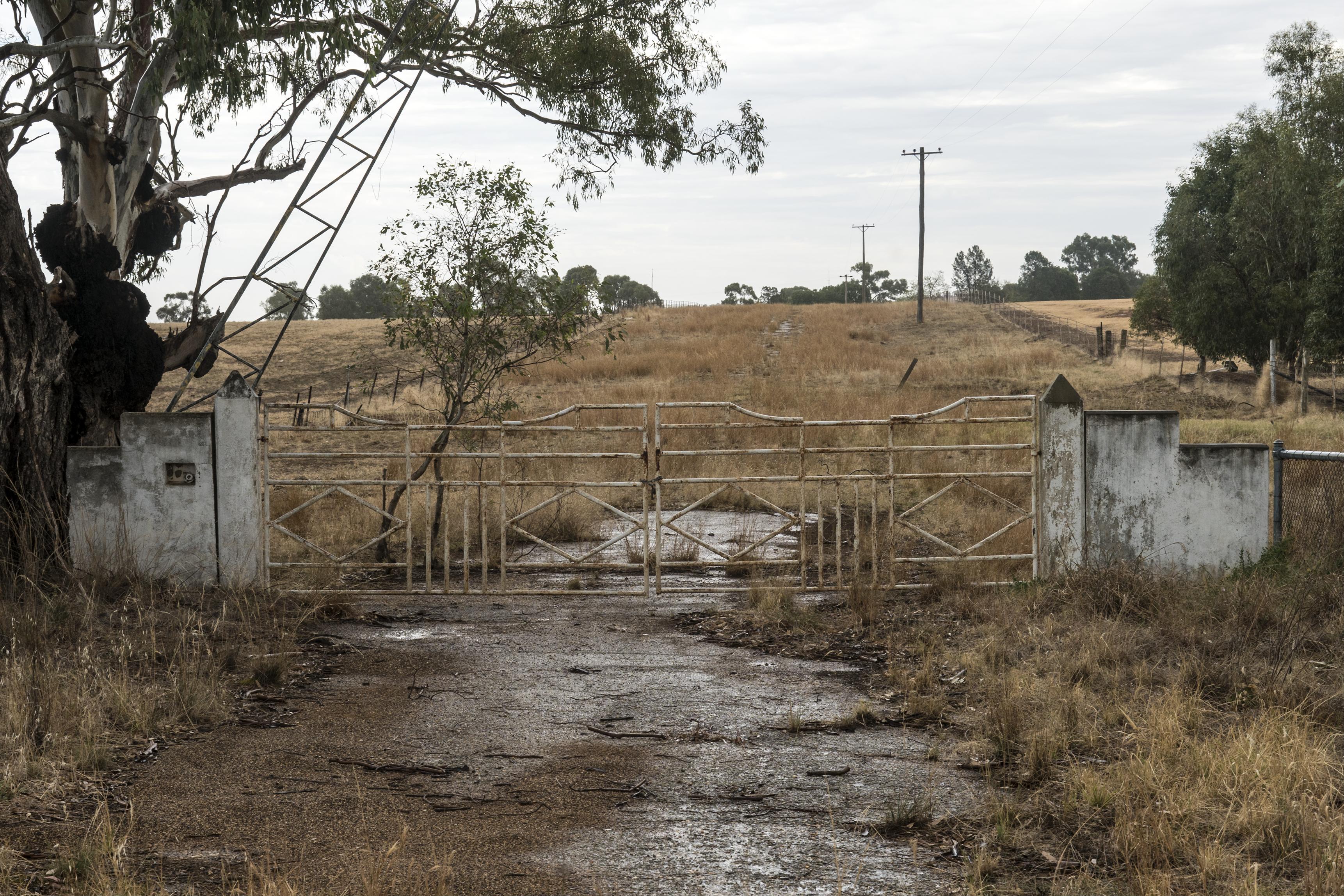
The once entrance to RAAF Uranquinty.
It was originally named Point Cooke, after John Murray Cooke, seaman on the frigate HMS Rattlesnake under the command of Captain William Hobson (later Governor of New Zealand). The ship brought the first government officials to Melbourne and surveyed the shore of Port Phillip during September to November 1836. Some official maps dropped the “e” as early as 1861 when research was conducted to ascertain whether Captain James Cook had any connection with the place (he didn't). Both names, Cooke and Cook were used for a while but common usage has meant the “e” has now been dropped permanently.

Under a restructure of flying training to cope with the demands of the Korean War and Malayan Emergency, No. 1 FTS was re-formed in 1952 as No. 1 Applied Flying Training School (No. 1 AFTS); it moved to Pearce in Western Australia, in 1958. For much of this period the school was also responsible for training the RAAF's air traffic controllers. Its pilot trainees included Army, Navy, and foreign students as well as RAAF personnel. The RAAF's reorganisation of aircrew training in the early 1950s had led to the formation back at Uranquinty of No. 1 Basic Flying Training School (No. 1 BFTS), which transferred again back to Point Cook in 1958. In 1969, No. 1 AFTS was re-formed as No. 2 Flying Training School and No. 1 BFTS was re-formed as No. 1 FTS. Rationalisation of RAAF flying training resulted in the disbandment of No. 1 FTS in 1993.
Nearly lost.
During the late 1980s and into the 90s, when Australia was in the depths of the depression “we had to have”, the drive for savings in efficiency and effectiveness led to deregulation, a free-market economy and privatisation of state assets. The economic environment of the time had a serious effect on the management of the Australian Defence Force. Point Cook was amalgamated with Laverton under a single command and management structure and the notional administrative entity of RAAF Williams was formed.
During this period, The Australian Defence Force Basic Flying Training School (BFTS) was located in Tamworth in northern New South Wales. It was run by BAE Systems Flying Training Academy, which conducted tri-service flight screening and basic flying training for the Australian Defence Force aircrew from the Army, Navy and Air Force using CT-4 Airtrainer aircraft. BFTS was raised in response to the RAAF and RAN beginning all-through training on the Pilatus PC-9 in December 1992. In 1993, Headquarters Training Command Detachment A was raised in Tamworth consisting primarily of civilian instructors. Army students were trained here as the PC-9 course was not appropriate. The detachment also screened prospective military pilots at this time. BFTS was officially reformed in 1999 and quickly began tri-service training.
The training preceded streaming into single service flying training, with RAAF and RAN pilots having moved to No. 2 Flying Training School (2FTS) at Pearce while Army pilots undertook further training at the Australian School of Army Aviation in Oakey, Queensland. All flying training was conducted by the ADF with the provision of aircraft and support services from BAE Systems Tamworth. Flying instructors were from all three branches of the ADF with several civilian flying instructors from BAE. The school formed part of Air Training Wing RAAF.
In 2015, BAE Systems lost a contract bid to Lockheed Martin Australia for the ab-initio training of pilots. Training was transitioned to No. 1 Flying Training School (1FTS) on the new Pilatus PC-21. The drawdown of training in Tamworth began in 2018 and the final ADF course graduated from BFTS in February 2019. In the years of operation, the school trained approximately 4000 military and flight screening students and operated over 280 000 flight hours. Flying training for the ADF is now conducted at 1FTS.
With Tamworth in full swing, it was not long before Point Cook was identified as suitable for disposal as surplus to Defence needs, however, the heritage value of Point Cook to the nation was too significant for some members of the community to allow it to pass into the hands of developers and a concerted effort to save Point Cook was mounted, of which the late Ted Ilton played a major part. The situation caused a long period of indecision that led to a decline in base maintenance and the gradual departure of RAAF units. By the early 21st century, the shift in focus from training operations to heritage significance was clear and the political will to sell Point Cook eventually faded.
Aircraft used at Tamworth included thirty-one CT/4 Airtrainers, three Mudry CAP-10 two seat aerobatic aircraft and two Piper PA-34 Seneca twin engine aircraft.
The school re-formed at East Sale in 2019, flying the new Pilatus PC-21 and conducting ab-initio flight training.
Steve Campbell-Wright, has written an interesting book titled “An Interesting Point” which is a complete history of Military Aviation at Point Cook from 1914 to 2014. You’ll find a copy of it in our book section HERE.

CT-4 Disposal.
On the 29th April, 1993, the RAAF’s last CT-4 Airtrainers were flown from Point Cook to the RAAF base at Wagga for storage pending disposal.
The formation of 18 aircraft overflew Melbourne en route, led by Wing Commander Robert Anderson, the last Commanding Officer of No 1 Flying Training School. After a decision was made, on cost-cutting grounds, to contract out initial flight screening of new student pilots to a civilian organisation from 1993, the conduct of flying training at Point Cook, the birthplace and spiritual home of the RAAF, had been brought to an end after 78 years.
The 36 aircraft held at Wagga were offered for sale to civil buyers at an auction held at Sydney in May 1993.
You can read more on the little CT-4 HERE
With these latest lockdowns, apparently we can't visit our relatives but real estate agents can buy and sell houses.
I've put my house on the market and my kids are coming for a viewing this afternoon.
RAAF Motto.
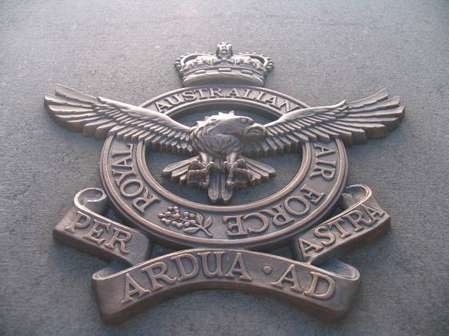
On the 18th August, 1932, the order was published which made Per Ardua ad Astra the official motto of the RAAF. Australia’s Chief of the Air Staff, Air Commodore Richard Williams, had first raised the idea of finding a suitable motto in late 1928, expressing his preference for something different to the RAF.
After unsuccessfully seeking suggestions from Latin scholars at the universities of Sydney and Melbourne, the Air Board decided in October 1929 to conform with other dominion air forces which had adopted the British motto and the process of securing Royal assent was put in train. In February 1932 the Australian Prime Minister was notified that approval had been granted, and the order promulgating the change followed two months later.
Various meanings were ascribed to Per Ardua ad Astra over the years, but in 2002 the Chief of Air Force formally accepted ‘Through Struggle to the Stars’ as the RAAF’s translation.
With the lockdowns, it would be a smart idea to put your jeans on every other day to make sure they still fit.
Pyjamas and trackies will have you believe all is well.
World War 1 revisited.
World War I was fought from 28th July 1914 to 11th November 1918. Because many of the combatants had colonies and alliances beyond continental Europe, it drew in others from around the world and due to the technological advances at the time, over 9 million soldiers and more than 7 million civilians were killed in those terrible 4 years.
WWI would change the map of Europe and end in such a way that made WWII inevitable. Despite its impact, even today there’s a lot that many don’t know about this conflict.
|
1. |
Soldiers of the Allied Powers and the Central Powers celebrated Christmas together. This is known as the Christmas Truce. By September 1914, both sides found themselves well-ensconced in trenches. The Germans were trying to break through into France, while the Allies were determined to avoid that and push them out.
As Christmas approached, ceasefires were called so both sides could bury their dead, but on the 25th December, something very strange happened. As many as 100,000 British and German soldiers put aside their guns, shook hands, and exchanged food and gifts. By 1915, however, as the casualties grew, the camaraderie ended and there were no more truces.
|
|
2. |
Aviators from both sides got along, American machine gunners shot down this German Hannover CL III in France’s Argonne region on 4th October 1918. Even after the Christmas Truce ended, Allied and Central pilots continued their camaraderie. It’s believed they saw themselves as a breed apart, and that flying distanced them emotionally from the horrors below.
In 1915, a German pilot who was downed behind Allied lines was first wined and dined by Allied aviators before they handed him over to the military. When an “enemy” pilot was shot down, aviators of the other side would fly over enemy territory to drop a note, letting them know if the downed pilot died or was taken alive into custody.
|
|
3. |
The war forced Britain to improve healthcare services for its people. Although the country entered the war at the height of its wealth and power, very little of that wealth reached the vast majority of the British people. Malnutrition was so widespread, that of the millions who applied to become soldiers, almost 40% had to be rejected.
Today, the average height of an adult British Caucasian male is about 5’9”. In 1914, their average height was 5’2”, though a member of the upper class stood about 5’6” These findings shamed the government into providing subsidized health care for common people.
|
|
4. |
Millions of minors served in the military. The official age required to become a recruit was between 18 and 19, but it was rarely enforced. Poverty and desperation forced many to lie about their age because they needed jobs and food. There were an estimated 250,000 minors from Britain, alone, the youngest being 12; while Canada sent over 20,000 minors.
Desperate for soldiers, some countries were willing to look the other way, while others, like France, encouraged boys as young as 15 to join. Once in, they were treated the same as the older men. Many died, as a result.
|
|
5. |
Canadian troops were feared by the Germans. Though most people think of Canada as a peaceful nation, Canadian soldiers developed a fierce reputation during the war. The Germans called them Sturmtruppen (storm troopers), because of their success in seizing enemy trenches and for taking extreme risks.
The Canadian soldiers also led the Allies to victory at the battles of Vimy and Passchendaele, which the British and French had failed to take. Whenever the Germans realized that Canadian forces were advancing, they prepared themselves for the worst. It’s perhaps no accident that Canadian soldiers were the highest paid among the Allies.
|
|
6. |
Canadian troops also had the highest rates of venereal disease. One out of every nine Canadians contracted some form of VD, six times higher than the average British soldier. For punishment, they had their pay suspended while they underwent treatment, and were required to pay a fine for every day they were out of action. To make it worse, infected soldiers were banned from taking leave for 12 months.
Since Canadians soldiers were the highest paid, they could afford to stay in hotels with private baths, which shocked most hoteliers. Such wealth must obviously have delighted their female “friends” however.
|
|
7. |
Many British nurses were aristocratic volunteers. To support their troops, several high-class British women set up First Aid Nursing Yeomanry (FANY). To join, one had to pay a fee, as well as provide monthly expenses for supplies. Since many came from wealthy families, they’d take their cars to France, then convert them into ambulances, again at their own expense.
Although they rendered valuable, often dangerous service at the risk of their own lives, they were not always well-received. Back then, women were expected to be subservient to men, but these were wealthy aristocrats who refused to obey the traditional norms.
|
|
8. |
High-ranking Allied POWs in Germany were trusted to stay put. Although low-ranking POWs were subjected to terrible conditions, high-ranking ones were generally trusted to stay put. Germans simply had them sign a document called a parole. Once they did, top brass POWs could leave their prison camp and go shopping in nearby villages and towns if they had money.
It was so effective that none who signed the parole actually tried to escape. One British officer claimed he planned to buy supplies in a German village for his escape, but once he signed the parole, honour bound him to stay.
|
|
9. |
Some Allied POWs were allowed to stay in hotels. As the war progressed, Germany found itself with far more POWs than it could handle. Those of rank who were badly injured or mentally shattered were sent to neutral Switzerland or Holland for better medical treatment.
Others were allowed to stay in hotels if they had money and have their families over for visits. There were so many Canadian POWs in Scheveningen, Holland that they set up a baseball club which played against a club set up by American POWs. So long as they were no longer fighting, Germany didn’t care.
|
|
10. |
More than half of the French Army mutinied in 1917. No one is sure exactly when it started, but a series of defections began in Northern France sometime after they lost at the Second Battle of the Aisne in April 1917. By then, the French had lost over a million soldiers, and they’d had enough.
The generals promised to end the war by May, but when the fighting continued, over 20,000 deserted their posts. The French are still secretive about the incident, but it’s known that more than 500 soldiers were executed for insubordination before the desertions finally stopped.
|

Dental Section – 3 RAAF Hospital, Richmond.
Back in 1969, Bob Hodgson, 38 Sqn Instrument Fitter and all round good bloke, had the odd visit to dental section. The lovely Jackie Eyre looked after him. You can see it HERE.
Wagga WRAAFs 1957
Back Row L-R: Mary Hale, Mary Harte, Betty Wear, Joyce Warrener, Avril Duncan, Pat Husking, Nan Dugan, Jean Sutton, Jackie Hasler, Joan Clift, Val Troy.
Middle Row L-R: Helen Gray, Varlene Young, Jan Wolwork, Patricia Sturgiss, Yvonne Kluver, Marie Hughes, Jean Burkhardt, Scottie Beaton, Marcelle Leahy, Errol Arndt.
Seated L-R: Kath Byrne, Wyn Sherwood, Judy Megueyer, Faye Stoate, Section Officer Buckman, Section Officer Hicks, Faye Drury, Margaret Farlow, Thelma Wagner, Mona Young.
The Bailey Bridge.
World War 2 could not have been won without this wonderfully simple piece of design – the humble Bailey Bridge
Picture an Allied tank commander in Europe, during Autumn, 1944. Advancing for days, destroying the German resistance. Nothing has been able to stop the invasion; except a blown bridge. Luckily, somewhere back in the supply columns which keep the army going, is a Bailey Bridge.
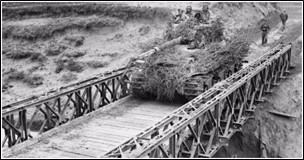
Donald Bailey, the designer of the Bailey Bridge, was born in Rotherham, UK, in 1901. He received his BA in Engineering from the University of Sheffield in 1923. After graduating, he helped design railway bridges in the 1930s, but by 1940 he was working for the War Department.
In Christchurch, Southern England he and a group of other engineers, comprised MEXE (Military Experimental Establishment). They were designing and testing new engineering equipment for the British Army. The Army at the time was facing a dilemma. They knew they would be required to fight in Europe, with its various canals, rivers, streams, and lakes. Any one of these could stop an army advancing, and they needed a foolproof way to cross them. Collapsible and portable bridges had been around for hundreds of years, in various forms, but by 1940, British weapons were outstripping engineering equipment.
Their tanks weighed more than 40 tons, but the heaviest portable bridge could hold only 26 tons. The Allies would be bogged down and delayed as engineers worked to repair existing bridges or build more permanent ones.
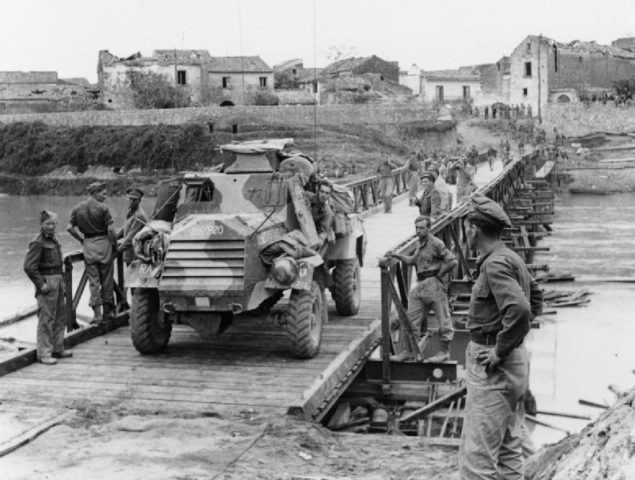
A Bailey Bridge like this had to be constructed to cross rivers. This took precious time but was eventually able to allow an Army to continue their advance.
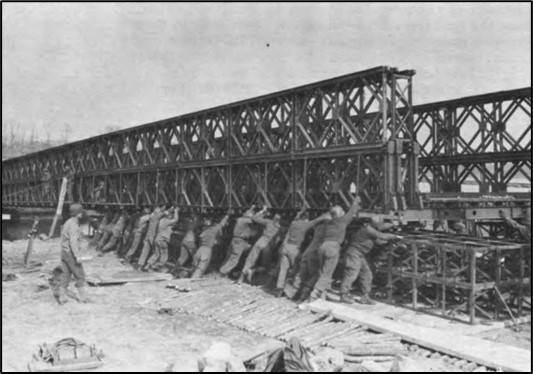
Donald Bailey was being driven back to his headquarters building after a failed bridge test. The world seemed to be collapsing around England, and everything they tried seemed to fail. The War Department was desperate for a reliable bridge. Suddenly, Bailey had an idea. He began sketching it out on the back of an envelope.
It was an amazingly simple design. Prefabricated panels each made up of internal trusses. These were joined by pegs, with large beams running across the bridge’s width. This gave them not only the rigidity needed to span a large area, but they could be assembled with simple tools: sledgehammers, rollers, and wrenches.
While not indestructible, the bridges were easily replaced and cheap. They proved sturdy enough to stand up to almost any stress but quick and cheap enough to be disposable.
Equally important, they were straightforward and cheap to produce. Almost any industrial fabricator could make the panels and pieces necessary, and mass production was a definite possibility. The Bailey Bridge had been born.
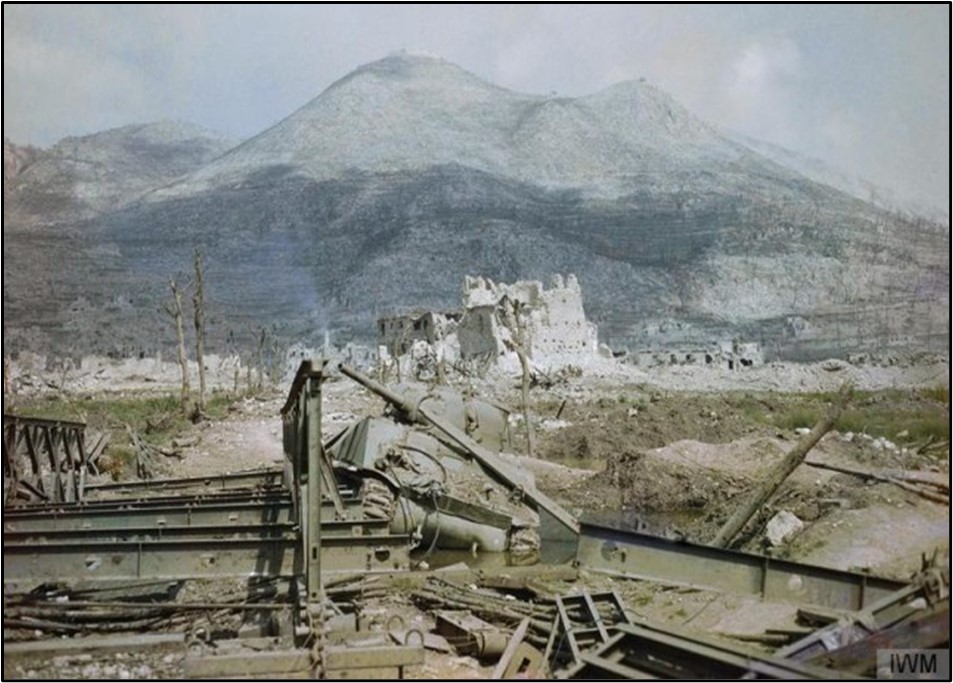
In the battlefield these bridges proved indispensable. Field Marshal Montgomery said they were necessary to the speed of the Allied advance during the war. In Italy and Sicily, over 55 miles of bridges were built, spanning everything from stream beds, to the 1,126 ft. Bridge over the Sangro River. The longest, which spanned the Chindwin River in Burma, was 1,154 ft.
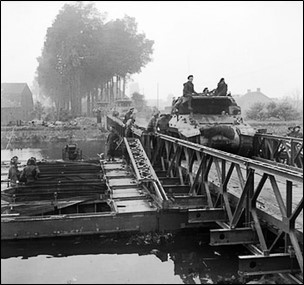
After D-day, in France, the low countries, and Germany, Bailey Bridges were consistently used to replace many of the bridges destroyed by the retreating Germans. Famously, the Son bridge was replaced with one during Operation Market Garden, in September 1944; eventually allowing Allied armour to press forward and help seize Nijmegen.
Today Bailey style bridges are a fixture of almost any modern military. The materials have been upgraded, but the basic design, prefabricated, interlocking sections which can be put together a myriad of ways, has not changed.
Their use has expanded to the civilian life, where they are often used for disaster relief and are permanent fixtures in some areas. Bailey might not be the best-known hero from World War 2, but his contribution to the war effort was immense, and his memory, and legacy, can not be forgotten.
In 1974, when a portion of the large concrete bridge that crossed the Derwent was destroyed, people who lived in East Hobart had a slow 50km, 90 minute, drive to get to the city until a Bailey Bridge (below) was opened in December 1985.
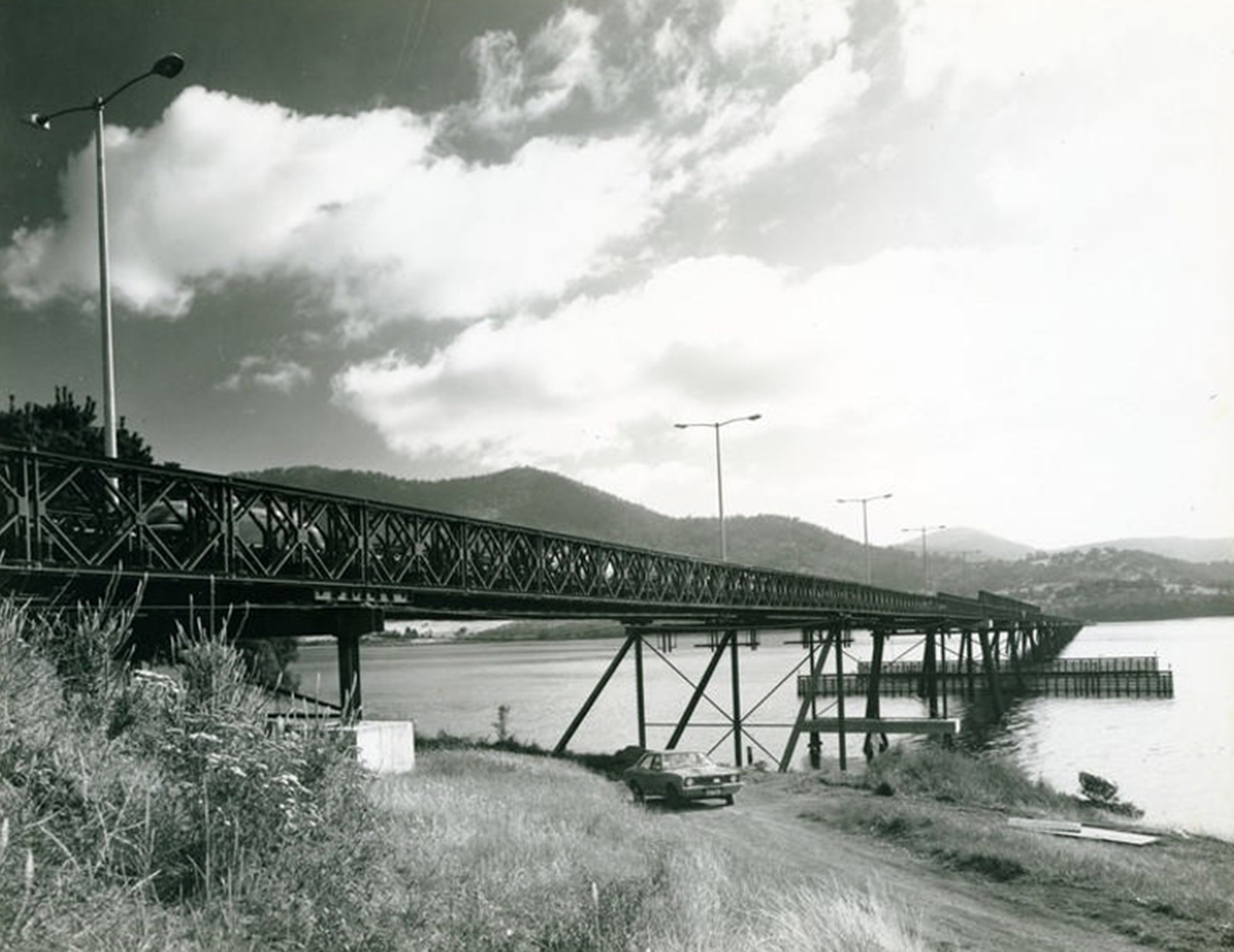
In 1974, when a portion of the large concrete bridge that crossed the Derwent was destroyed, people who lived in East Hobart had a slow 50km, 90 minute, drive to get to the city until a Bailey Bridge (above) was opened in December 1985.
Redneck car disposal. Ya gotta laugh!!
Back Go to page: 1 2 3 4 5 6 7 8 9 10 11 12 13 14 15 16 17 18 19 20 Forward
